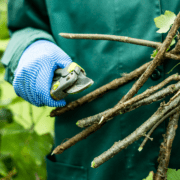The Versatile Dwarf Conifer
Why You Need Conifer Trees
by Chris McLaughlin
Conifer trees are easy to recognize with their evergreen, needle-type leaves and the cones on their branches.
In my opinion conifers offer some solid, reliable backbone to any yard — not to mention they’re handsome. I don’t know about you, but aside from the useful plants, I enjoy a little handsome in my yard, too. Standard conifers get big, like 50 or 70 feet tall, big. There’s a lot of us that can’t offer a proper home to such a monster, handsome or not.
Enter the dwarf conifers. You can fit a ton of these versatile mini-versions into a small landscape as they have a compact growth habit, which makes them container friendly, too. By using grafting techniques or rooted cuttings, dwarf conifers are reproduced asexually. By the way, when they’re grafted, it’s not onto dwarfed rootstock; they’re cultivars originating from mutations or seedling selections.
Unlike other plants that are grafted onto a smaller plant’s roots or “dwarf rootstock”, dwarf conifers or dwarf evergreens are simply tree or shrub varieties that are extremely slow-growing. In other words, they haven’t been bred to stop growing at a certain height. According to conifer nurseries, a regular hemlock will grow to reach 25′-30′ tall in 20 years time. While its dwarf hemlock cousin will reach 2′ in that same amount of time.
“Witches brooms” are another way to get a dwarf conifer. These mini conifers usually start as a bud that can be found anywhere on a regular conifer tree. Sometimes a bud’s genes will mutate and produce a clump of growth that’s dwarfed. They’re harvested from the parent plant and more plants are propagated from the brooms — creating more dwarf specimens.
Dwarf conifers bring year-round interest to the landscape and many perform seasonal color changes. Keep your eye out for variegated varieties and those in various shades of green, orange, blue, yellow, and lavender. Some also have patterned or bi-colored leaves, as well. Inside this conifer class are the yews and junipers that produce berries instead of cones. Also, along with the pines are firs, spruces, redwoods, cedars, cypresses, junipers, yews, and hemlock. Word of warning; cypresses do lose their leaves come fall.
Dwarf conifers come in many shapes and forms (just in case you can only picture a Christmas tree):
• Prostrate: These are plants that hug the ground like a carpet (and stay that way).
• Globose: These have a rounded, globe shape to them.
• Narrow upright: These plants grow taller than they do wide.
• Pendulous: These plants grow upright with branches that hang down or have a downward curving leader and require staking. Or they can have strictly descending branches from a central leader.
• Spreading: While these are upright, they grow wider than they do tall.
• Broad upright: These are all of the plants that grow upright but aren’t in the globose, narrow upright, or pendulous categories. Generally, these grow broader than they do tall.
• Irregular: These guys grow erratically without a pattern.
• Culturally altered: This means that someone made their own shape(s) with some pruning shears. Think topiary shapes.
Dwarf conifers are one of my favorite plant group of all time. If you’re interested in making them yours, check out The American Conifer Society’s website.



Leave a Reply
Want to join the discussion?Feel free to contribute!